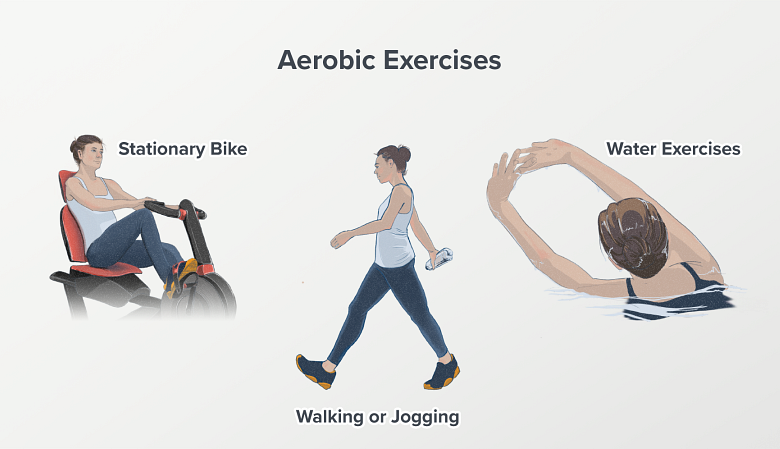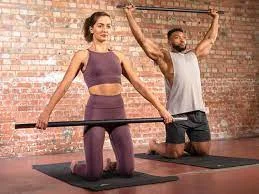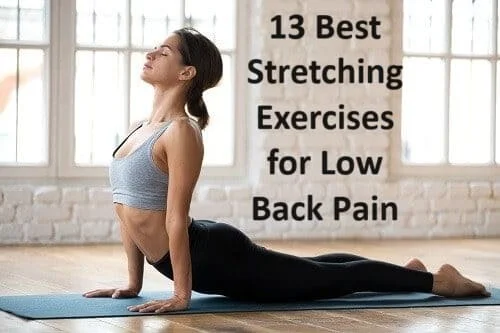What Is an Example of Aerobic Exercise?
Aerobic workout affects physical activity that improves your breathing and heart rate to fuel your body with oxygen-rich blood. Aerobic training assists in supporting your heart muscle, enhances your lung function, and improves circulation and healthy blood flow throughout your body.
What Is Aerobic Exercise?
Since the word “aerobic” means “with oxygen,” aerobic exercise refers to any physical activity in which your body uses more oxygen overall. Your muscles need more oxygen while you work to contract for extended periods. Adenosine triphosphate (ATP), the main energy source for cells, is created during cellular respiration, which occurs during aerobic exercise. Oxygen and other molecules are transformed during this process.
To pump more oxygen-rich blood throughout the body and give your muscles more oxygen, your heart rate will rise. To boost the amount of oxygen in the blood and body, your breathing rate will also rise. Aerobic exercise is sometimes referred to as cardiovascular exercise, or simply “cardio,” since it increases the functioning of your heart, lungs, and cardiovascular system.
Aerobic vs. Anaerobic Exercise
Anaerobic training, or “without oxygen,” consists of brief bursts of activity in which muscles are powered by the breakdown of their energy stores. Aerobic exercise, or “with oxygen,” requires greater oxygen to supply working muscles over a lengthy period.
Here we describe different benefits of aerobic exercise:
- Enhance heart function and reduce resting heart rate
- Enhance lung function
- Enhance oxygen supply throughout the body
- Enhance circulation
- Reduce high blood pressure (hypertension)
- Reduce inflammation throughout the body
- Enhance mood and energy
- Reduce the chance of developing conditions like diabetes, heart disease, and stroke
- Reduce your blood sugar
- Lower high cholesterol and triglycerides
- Improve weight loss
- Building stronger bones.
- Enhancing your muscle strength, endurance, and flexibility.
- Enhancing your balance.
- Improving your mental function.
- Helping in weight management and/or weight loss.
- Raise HDL or “good” cholesterol.
Here we describe the Examples of Aerobic Exercise:
Aerobic workouts are normally any exercises that get your body moving for a lengthy period, such as:
- Walking
- Jogging
- Running
- Hiking
- Bicycling
- Swimming
- Jumping rope
- Dancing
- Stair climbing
- Rowing
- Playing sports
How Much Aerobic Exercise Should You Do?

Adults should do one of the following physical activity durations each week to promote optimal heart health and reduce the risk of developing atherosclerotic cardiovascular disease :
- 140 minutes of moderate-intensity physical workout
- 80minutes of vigorous-intensity physical workout
- comparable amounts of both intense and moderate exercise
The following categories are used to classify exercise intensity:
- Light intensity: Walking slowly, cooking, light housework
- Moderate intensity: Moderately intense activities include dance, active yoga, brisk walking (2.4–4.0 miles per hour), bicycling (5–9 miles per hour), and
- Vigorous intensity: Running, jumping rope, stair climbing, bicycling (over 10 miles per hour), swimming laps, weight lifting, aerobics, and shoveling snow
How to Get Started?
people who live sedentary lifestyles should begin slowly and gradually raise exercise intensity, duration, and frequency. This permits the heart, lungs, and muscles to adapt to the change in physical training. Aerobic exercise can be broken up into 10-minute sessions for beginners to assist in making training more manageable and attainable.
Shorter durations of physical activity of ten minutes or less can be just as useful as longer durations greater than 10 minutes, as long as the total duration of exercise throughout the week remains the same. Fifteen-minute workout sessions split throughout the week, for example, can have similar advantages as five 30-minute sessions.
If you cannot meet these suggestions, it is generally better to participate in some form of training rather than no activity unless your healthcare provider recommends you evade physical training for medical situations.
Always consult with your healthcare provider before starting or increasing any exercise schedule to ensure that your heart, lungs, and blood vessels are healthy sufficiently to support the improved demands of aerobic exercise.
Aerobic training is any type of cardiovascular conditioning, or “cardio.” It can contain activities like brisk walking, swimming, running, or cycling.
By definition, aerobic exercise means “with oxygen.” Your breathing and heart rate will rise during aerobic workouts. Aerobic exercise helps maintain your heart, lungs, and circulatory system healthful.
Aerobic exercise varies from anaerobic exercise. Anaerobic exercises, such as weightlifting or sprinting, involve brief bursts of energy. They are done for a short period with all of your effort. This is unlike aerobic workouts. You complete aerobic exercises for a sustained period.
Read on to learn more about aerobic activities you can try at home and the gym. And recognize, always talk with your doctor before starting a new aerobic workout routine.
Here we describe details of aerobic exercise:
At-home aerobic exercise
Cardiovascular exercises can be done at home. There are many you can do with little to no tools, too. Continuously warm up for 5 to 10 minutes before beginning any exercise.
Jump rope
Equipment: shoes, rope
Benefits: This will help create better body awareness, hand-foot coordination, and agility.
Safety: Make sure your rope is the right height for you. Place both feet in the center of the rope and reach up to your armpits with the handles. That’s the height you intend to reach. To prevent tripping over the rope, trim or tie off any excess length.
Duration and frequency: 20 to 25 minutes, 3 to 4 times per week
Jump rope circuits are excellent for both indoor and outdoor use, but you should make sure you have enough room. It should take 15 to 25 minutes to finish your circuit program.
If you are a beginner:
Swing the jump rope under your feet and over your head as you begin to jog ahead. Try this for fifteen seconds.
Next, keep swinging the jump rope while you jog backward in the opposite direction. Try this for fifteen seconds.
Do a 15-second hopscotch jump to complete your set. To perform this exercise, stand with the rope in the middle and bounce back and forth, alternating between bringing your feet to the sides and back to the center, just like you would when performing jumping jacks. Try this for fifteen seconds.
Take a 15-second break in between sets.
18 times, repeat.
If you’re an intermediate exerciser, you can do each set of exercises in 30 seconds, with a 30-second break in between. One should perform the advanced circuit for 60 seconds at a time, and then take a 60-second break.
Aerobic strength circuit
Equipment: shoes, steady chair, or couch for dips
Benefits: This activity raises heart and
cardiovascular health builds strength, and tones main muscle groups.
Safety: Concentrate on the correct form with each workout to avoid injury. Throughout, maintain a moderate heart rate. You should be able to bring on a brief discussion during this exercise.
Duration and frequency: 20 to 25 minutes, 4 to 5 times per week
This aerobic rotation is designed to get your heart rate up. do the following strength exercises for 1 minute:
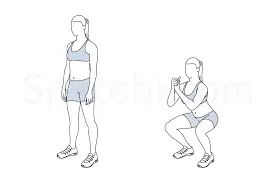
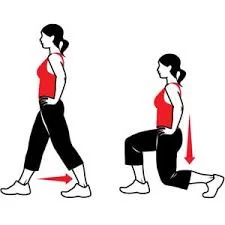
- squats
- lunges
- pushups
- triceps dips
- torso twist
After that, take a minute to jog or march still as your active rest. Repeat the circuit two to three times. You can rest for up to five minutes between circuits. Afterward, stretch a little to cool down.
Running or jogging
Equipment: running shoes

Benefits: Running and jogging are some of the most effective forms of aerobic exercise. To just a few benefits, it can elevate your mood, burn calories and fat, and strengthen your heart.
Safety concerns: Select well-lit running routes. Inform someone about your plans.
Duration and frequency: 15 to 30 minutes, 2 to 3 times per week
If you’re new to exercise, run for 5 to 10 minutes twice a week and gradually increase as you improve. During the run, your pace should be conversational. To begin, you can switch between five minutes of jogging and one minute of walking. You have to do stretching after the workout to prevent injury.
Walking
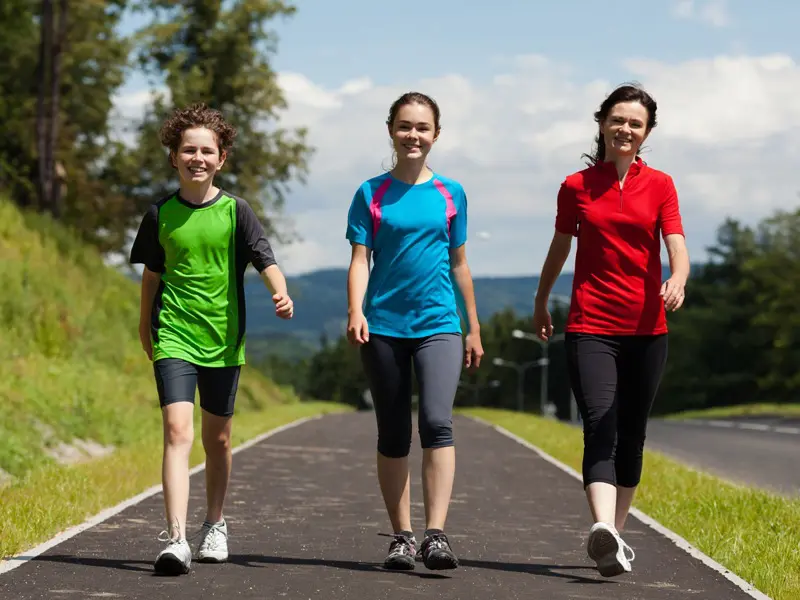
Equipment: gym shoes (sneakers)
Benefits: Walking daily can lower your chances of depression, high blood pressure, diabetes, obesity, and heart disease.
Safety: Walk in well-lit and populated areas. Select footwear that provides adequate ankle support to lower your chance of injury.
Duration and frequency: 130 minutes per week, or 30 minutes five days a week
If you primarily exercise by walking, try to achieve 150 minutes a week. This can be divided into five days a week of walking for thirty minutes each. Alternatively, walk rapidly for ten minutes at a time, three times a day.
A fitness tracker is another useful tool for monitoring your daily step count. Start with your base, or the number of steps you now do each day, and gradually increase it if your objective is to walk 10,000 steps a day.
Therefore, add 500–1,000 steps after determining your basis. After that, give yourself an extra 500–1,000 steps a day for a period of one to two weeks.
Aerobic gym exercises
A wonderful place to get some aerobic workouts is your local gym. They most likely have elliptical machines, stationary cycles, and treadmills. You might also be able to swim laps in the pool.
Always seek advice from a specialist or trainer if you are unsure how to utilize a particular piece of exercise equipment.
Swimming
Equipment: pool, swimsuit, goggles (optional)

Benefits: Since swimming is a low-impact activity, it is beneficial for those who are prone to injuries, are recuperating from injuries, or have restricted mobility. It can support the development of strength, endurance, and muscle tone.
Safety: Choose a pool with a lifeguard on duty if at all feasible to avoid swimming by yourself. If you’ve never swimmed before, start with swim lessons.
Duration and frequency: Twice a week, for two to five minutes. To extend your swimming time, add 5 minutes to your weekly swim time.
If there’s a pool at your gym, consider swimming as an aerobic workout. Because it’s a low-impact exercise, it’s a smart option if you’re prone to injuries. In addition, you’re strengthening your muscles, raising your heart rate, and developing your stamina and strength without putting further stress on your body.
One way to get started is by swimming circles with a single stroke, like freestyle. Add more strokes as you get to experience swimming. One to four laps of freestyle, for instance, might be followed by one to four laps of backstroke or breaststroke.
Between laps, stretch out on the pool’s edge if you’re feeling fatigued. Always abide by the rules and safety recommendations posted at the swimming pool.
Stationary bike
Equipment: stationary bike
Benefits: This low-impact workout can improve cardiovascular endurance and leg strength.
Safety: Ask a trainer at the gym for assistance setting the bike’s seat height correctly. By doing this, you’ll be less likely to get hurt or fall off your bike.
As a general guideline, when riding a bike at home, you should set the seat height so that, before achieving full extension, your knee still bends 5 to 10 degrees. By doing this, the pressure on your knee joint is lessened. On a stationary bike, it is not advised to fully extend your knee when riding.
Duration and frequency: Three times a week for 35 to 45 minutes
Another low-impact fitness alternative is to ride a stationary bike. In addition to being easy to use and providing a decent cardiovascular workout, stationary bikes also help increase leg strength. Cycling classes are available at many gyms and fitness centers; these classes use stationary bikes. However, if you don’t enroll in a class, you can still gain from a stationary bike workout.
Increase your speed to 75 to 80 rotations per minute (RPM) and aim for 20 to 30 minutes of consistent cycling after stretching and warming up with five to 10 minutes of easy riding. Take five minutes to cool down. Extend until the end.
To avoid feeling like your feet are being pushed by the pedals, adjust the resistance on the bike so that you feel like you are moving the pedals. To make the activity more difficult, increase the resistance.
Elliptical
Equipment: elliptical machine
Benefits: When it comes to the knees, hips, and back, elliptical machines offer a better cardiovascular workout than a treadmill or running on the road or trails.
Safety: Consider the future rather than the past. To help you get on and off the machine or if you feel unstable, use the handlebars.
Duration and frequency: 20 to 30 minutes, two to three times a week.
Though first daunting, the elliptical machine is simple to operate once you get the hang of it. Maintain an erect posture and cycle the machine with your legs after warming up for five to ten minutes at a gentle rhythm.
Keep your gaze forward and not down at your feet at all times. Maintain a back hunch and tense abdominal muscles. Stretch after letting the machine cool down. To make the exercise more difficult, turn up the resistance on the machine.
Aerobic class workouts
If working out by yourself isn’t your thing, a class might offer a motivating and helpful setting. If you’re new, ask the instructor to demonstrate the correct form for you. If needed, they can assist you in changing the workouts if you’re a newbie.
Start by attending group sessions two or three times a week at your neighborhood fitness center. If you get enjoyment from the workout, you can always go more often later on.
Cardio kickboxing
Equipment: gym shoes (sneakers)
Benefits: Kickboxing is a high-impact workout that builds strength and endurance. It may also relieve stress and enhance your reflexes.
Safety: Consume plenty of water throughout the class. Stop and take a break if you start to feel dizzy.
Duration and frequency: 50 minutes, 2 to 3 times per week
Martial arts, boxing, and aerobics are all combined in cardio kickboxing. Your lesson might start with a strength-training exercise like pushups or jumping jacks, or it could involve running. The main workout will then consist of a series of punches, kicks, and hand strikes.
At the end, there can be strengthening or core exercises. Always cool down and stretch after working out.
Zumba
Equipment: gym shoes (sneakers)

Benefits: Zumba tones your entire body, strengthens your heart, enhances coordination, and may help reduce stress.
Safety: Drink plenty of water throughout the lesson. If fatigue or vertigo sets in, take a rest. If you are prone to ankle injuries, you might wish to wear shoes that offer strong ankle support.
Duration and frequency: 60 minutes, once or twice a week
Zumba is a fantastic option for an aerobic workout if you enjoy dancing. Following a brief warm-up, your instructor will lead the class through simple dance moves to lively music. Stretching and a cool-down will come last.
You must wear shoes. Make sure you stay hydrated during the entire class. If you are fatigued, you may always take a break and come back.
Indoor cycling class
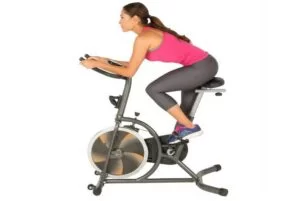
Equipment: stationary bike, padded cycling trousers or shorts and cycling shoes (optional)
Benefits: Classes for indoor cycling increase cardiovascular endurance, muscle tone, and strength.
Safety: Get help from the instructor in assembling the stationary bike if you’re new or in need of a refresher. If you are weary or dizzy, reduce your resistance or take a rest.
Duration and frequency: 45–60 minutes, once or three times a week
A cycling class will raise your heart rate in contrast to a relaxing bike ride. For the most training effects, it might contain both resistance and climb (incline) sections. Your muscles will become more toned and strong as a result of this. Cycle shoes that you “clip” into the bike are required for some classes. Usually, your facility has this available hire.
The majority of lessons last 45 to 60 minutes and include stretching, cool-down, and warm-up. You should bring water to class. If you’re new, you can take a break from pedaling by lowering the resistance on the bike and doing light strokes.
How much aerobic exercise do you need?
It is recommended to engage in aerobic exercise for at least 30 minutes five days a week by the American Heart Association Trusted Source. That is, however, breakable. You could, for instance, go for three walks of ten minutes each day.
Additionally, you want to incorporate two or more anaerobic strengthening exercises per week that target the main muscle groups.
Exercise safety
See your physician if you have never exercised before. They can evaluate your health and suggest a safe and efficient exercise program for you.
Warming up should always come first, followed by a cool-down and stretches. Keep your form in mind and stop if it hurts.
What are the risks of aerobic exercises?
Participating in physical exercises can put you at risk of damage, including:
- Sprains and strains.
- Bone fracture.
- Joint pain.
- Muscle cramps
- Pain or soreness.
Warming up and cooling down
Every session of aerobic activity should contain a warmup and cooldown period. Instead of static stretching, the warm-up should steadily increase the exercise’s tempo and intensity. This lowers the chance of muscle or joint damage and enables your body to improve blood flow to your muscles. Five to ten minutes should be dedicated to the warm-up. With a progressively slower speed, the cooldown should take about the same length as the warmup. It would be appropriate to perform stretches following an aerobic workout.
Progression of aerobic exercise
Throughout your workout, you should change the amount of work your body does throughout training or the progression of training to higher intensities. The training program’s advancement should be determined by your strength and tolerance. If you’re just starting go slowly. You can gradually increase the amount of labor your body does throughout a workout if you’re preparing for a marathon.
Three methods exist for advancing an aerobic workout:
- Improve speed.
- Boost resistance.
- Growth duration (time).
You can improve your aerobic fitness by using one of these techniques alone or in combination. Increased intensity should be applied very gradually. It’s best to push yourself for little periods at a time.
Summary
Your heart rate and breathing rate go up during aerobic exercise because your muscles need more oxygen to function. Aerobic exercise, sometimes called “cardio,” is sustained physical exertion. Aerobic exercise includes walking, hiking, running, dancing, riding a bike, and participating in sports. This exercise improves circulation, lowers high blood pressure, cholesterol, and inflammation, and strengthens your heart and lungs. Start slowly and build up to your desired level of aerobic exercise over time. Make sure you are cleared by your healthcare physician first, though.
Engaging in aerobic exercise can help you keep your heart healthy and reduce your chance of developing systemic inflammation. To give your body time to adjust to the new activity, start cautiously and progressively increase the intensity, frequency, and length of your physical activity.
FAQ
What is the amount of calories burned during aerobic exercise?
The number of calories expended during aerobic exercise varies according to your weight, level of personal fitness, exercise intensity, and length of time spent exercising.
Is practicing yoga a form of aerobic exercise?
Power yoga, also known as vinyasa yoga, is one type of yoga that is an aerobic practice that calls for quick adjustments to poses and movements.
Do aerobic exercises aid in the loss of abdominal fat?
Cardio exercises boost your energy expenditure because they put more strain on your heart and lungs to pump blood rich in oxygen to your working muscles. You can shed fat, especially belly fat, by breaking down excess fat tissue and increasing your caloric intake due to this higher effort.
Does aerobic exercise help people lose weight?
Because it requires more effort from your heart and lungs to pump oxygen-rich blood to your working muscles, aerobic exercise is beneficial for weight loss. You can lose weight by burning more calories and breaking down fat tissue as a result of this increased workload.
What are some examples of aerobics?
Aerobic exercise is a type of repetitive, rhythmic physical activity that
works for your body’s main muscle groups. Both your heart rate and your body’s oxygen consumption increase as a result. Aerobic exercises encompass activities like walking, cycling, and swimming.
What is another name for aerobic activity?
Another name for aerobic exercise is endurance exercise. When you exercise, your heart beats more quickly. This kind of exercise also causes you to breathe more heavily. Over time, consistent aerobic activity strengthens and enhances the efficiency of your heart and lungs.
References
- Dpt, K. G. P. (2023, September 3). What is aerobic exercise? Verywell Health. https://www.verywellhealth.com/aerobic-exercise-5218112
- Chertoff, J. (2022, July 11). 10 Aerobic exercise examples: how to, benefits, and more. Healthline. https://www.healthline.com/health/fitness-exercise/aerobic-exercise-examples
- Professional, C. C. M. (n.d.-a). Aerobic exercise. Cleveland Clinic. https://my.clevelandclinic.org/health/articles/7050-aerobic-exercise
- GoodRX – error. (n.d.). https://www.goodrx.com/well-being/movement-exercise/aerobic-exercise
- Cde, R. W. M. (2023, November 16). Aerobic exercise benefits, examples at home and what is it? MedicineNet. https://www.medicinenet.com/aerobic_exercise/article.htm

